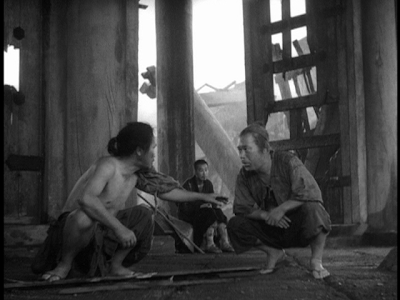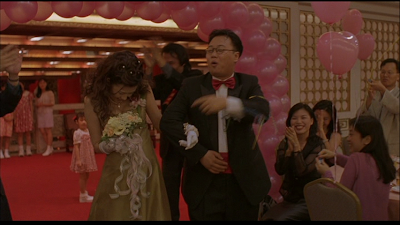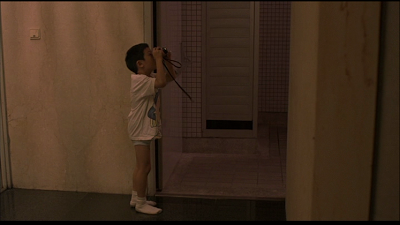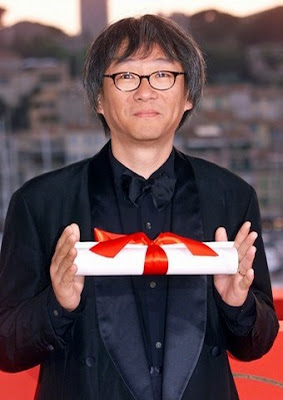 Rashomon
RashomonA film by Akira Kurosawa
Year:1950
Country:Japan
Japanese with English sub titles
Run time:88 min
6th Sept 2009 ; 5.45 pm
http://konangalfilmsociety.blogspot.com/
Call 94430 39630
 Main screening will be followed by an introduction to Rashomon by Robert Altman and interviews with Akira Kurosawa and Rashomon's cinematographer Kazuo Mjyagawa.
Main screening will be followed by an introduction to Rashomon by Robert Altman and interviews with Akira Kurosawa and Rashomon's cinematographer Kazuo Mjyagawa. Rashomon opens in a ruined 8th century temple, where a woodcutter and a Buddhist priest, taking shelter from a lashing rain, ponder a bewildering crime that has shaken their faith in men. As they recount the crime to a cynical passerby, flashbacks picture the testimony at the trial and four differing re-enactments of the violent incident itself.
Rashomon opens in a ruined 8th century temple, where a woodcutter and a Buddhist priest, taking shelter from a lashing rain, ponder a bewildering crime that has shaken their faith in men. As they recount the crime to a cynical passerby, flashbacks picture the testimony at the trial and four differing re-enactments of the violent incident itself. The story told by Rashomon is both surprisingly simple and deceptively complex. The central tale, which tells of the rape of a woman (Machiko Kyo) and the murder of a man (Masayuki Mori), possibly by a bandit (Toshiro Mifune), is presented entirely in flashbacks from the perspectives of four narrators.
The story told by Rashomon is both surprisingly simple and deceptively complex. The central tale, which tells of the rape of a woman (Machiko Kyo) and the murder of a man (Masayuki Mori), possibly by a bandit (Toshiro Mifune), is presented entirely in flashbacks from the perspectives of four narrators. Each re-telling has its own tone, and distinct point-of-view. Director Akira Kurosawa does a brilliant job of manipulating the mood, while each of the main actors is excellent. Toshirô Mifune (Kurosawa’s long-time leading man) as the thief and Machiko Kyô as the rape victim are particularly riveting.
Each re-telling has its own tone, and distinct point-of-view. Director Akira Kurosawa does a brilliant job of manipulating the mood, while each of the main actors is excellent. Toshirô Mifune (Kurosawa’s long-time leading man) as the thief and Machiko Kyô as the rape victim are particularly riveting. Kurosawa keeps things tight and intimate — much of it is essentially a filmed play — but keeps us off-balance with the pacing, which tends towards the glacial in any scene involving the woodcutter (whose initial walk in the woods seems to go on for minutes on end) but picks up and gathers tension when we flash back to the murderous dishonor played out amid the trees. Weather is also used ironically — the violent events unfold in harsh sunlight, while the post-mortem groping for truth happens against a backdrop of tears from heaven.
Kurosawa keeps things tight and intimate — much of it is essentially a filmed play — but keeps us off-balance with the pacing, which tends towards the glacial in any scene involving the woodcutter (whose initial walk in the woods seems to go on for minutes on end) but picks up and gathers tension when we flash back to the murderous dishonor played out amid the trees. Weather is also used ironically — the violent events unfold in harsh sunlight, while the post-mortem groping for truth happens against a backdrop of tears from heaven. Thematically, Rashômon is a challenging philosophical exercise. Technically, the film is a tour de force of editing discipline and dramatic construction. The actors must recreate the same scene four times, playing their characters in completely different ways.
Thematically, Rashômon is a challenging philosophical exercise. Technically, the film is a tour de force of editing discipline and dramatic construction. The actors must recreate the same scene four times, playing their characters in completely different ways. By the end of the movie, our emotions have been rubbed raw because we have been unable to empathize with a particular version of events. We finish in a moral quandary for we are no closer to determining the 'objective' truth than we were at the start of the film
By the end of the movie, our emotions have been rubbed raw because we have been unable to empathize with a particular version of events. We finish in a moral quandary for we are no closer to determining the 'objective' truth than we were at the start of the film
Akira Kurosawa was the youngest of seven children, born in Tokyo on 23 March 1910. A talented painter, he enrolled in an art school that emphasized Western styles. Around this time he also joined an artists' group with a great enthusiasm for nineteenth-century Russian literature, with Dostoevsky a particular favourite. Another influence was Heigo, one of his brothers, who loved film and worked as a benshi, a film narrator/commentator for foreign silent films. His suicide deeply affected the director's sensibilities.In 1930 he responded to a newspaper advertisement for assistant directors at a film studio and began assisting Kajiro Yamamoto, who liked the fact he knew 'a lot about things other than movies'. Within five years he was writing scripts and directing whole sequences for Yamamoto films. In 1943 he made his debut as a director with Judo Saga (Sanshiro Sugata), with a magnificent martial-arts sequence.
His early films were produced during the Second World War, so had to comply to themes prescribed by official state propaganda policy. It was Drunken Angel which was Kurosawa's first personally expressive work, made in 1948 and featuring Toshiro Mifune who became Kurosawa's favourite leading man.
For those who discover Kurosawa, they will find a master technician and stylist, with a deep humanism and compassion for his characters and an awe of the enormity of nature. He awakened the West to Japanese cinema with Rashomon, which won the top prize in the Venice Film Festival of 1951, and also a special Oscar for best foreign film. A golden period followed, with the West enthralled by his work. Seven Samurai, Yojimbo etc.
Following Red Beard (Akahige) in 1965 he entered a frustrating period of aborted projects and forced inactivity and when in 1970 his first film in five years (Dodeska-den) failed at the box office, he attempted suicide. Directing a Soviet-Japanese production, Dersu Uzala helped him to recover and took four years to make. It won the Oscar for Best Foreign Film in 1975 and a gold medal at the Moscow Film Festival.
A true auteur, he supervised the editing of nearly all his films and wrote or collaborated on the scripts of most. His memoirs were published in 1982, titled Something like an Autobiography. In 1989 he won an Oscar for Lifetime Achievement. Kurosawa died in 1998.
His early films were produced during the Second World War, so had to comply to themes prescribed by official state propaganda policy. It was Drunken Angel which was Kurosawa's first personally expressive work, made in 1948 and featuring Toshiro Mifune who became Kurosawa's favourite leading man.
For those who discover Kurosawa, they will find a master technician and stylist, with a deep humanism and compassion for his characters and an awe of the enormity of nature. He awakened the West to Japanese cinema with Rashomon, which won the top prize in the Venice Film Festival of 1951, and also a special Oscar for best foreign film. A golden period followed, with the West enthralled by his work. Seven Samurai, Yojimbo etc.
Following Red Beard (Akahige) in 1965 he entered a frustrating period of aborted projects and forced inactivity and when in 1970 his first film in five years (Dodeska-den) failed at the box office, he attempted suicide. Directing a Soviet-Japanese production, Dersu Uzala helped him to recover and took four years to make. It won the Oscar for Best Foreign Film in 1975 and a gold medal at the Moscow Film Festival.
A true auteur, he supervised the editing of nearly all his films and wrote or collaborated on the scripts of most. His memoirs were published in 1982, titled Something like an Autobiography. In 1989 he won an Oscar for Lifetime Achievement. Kurosawa died in 1998.






















